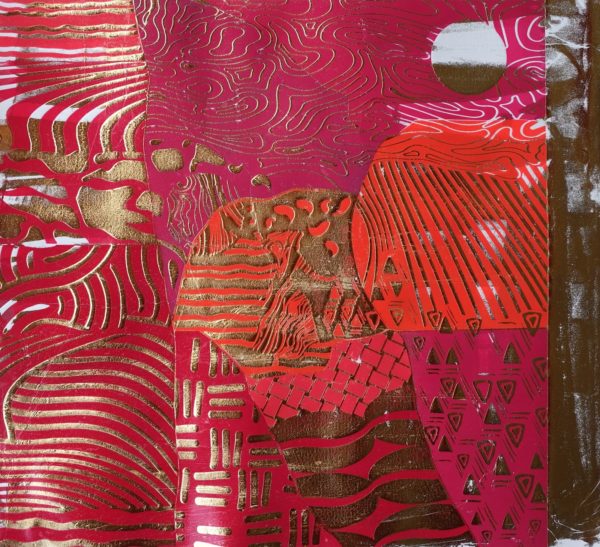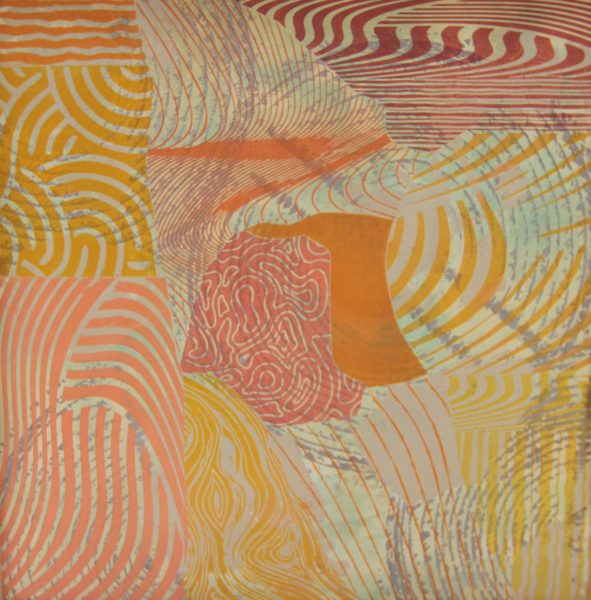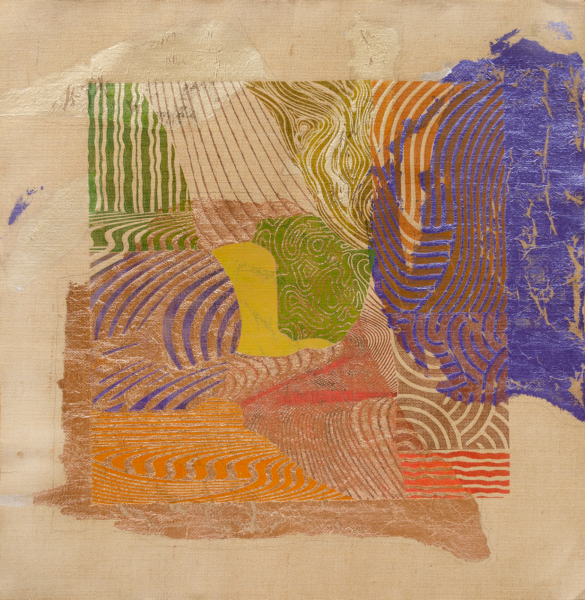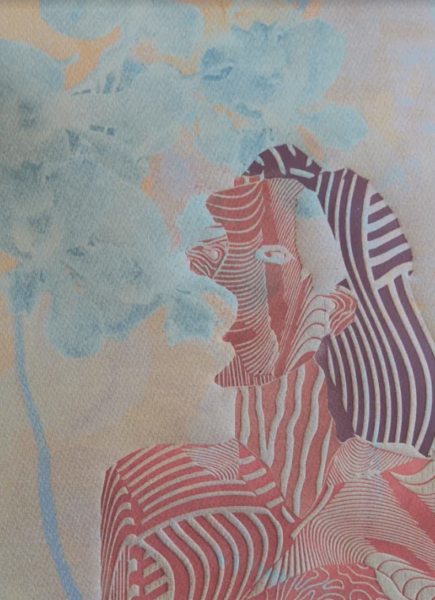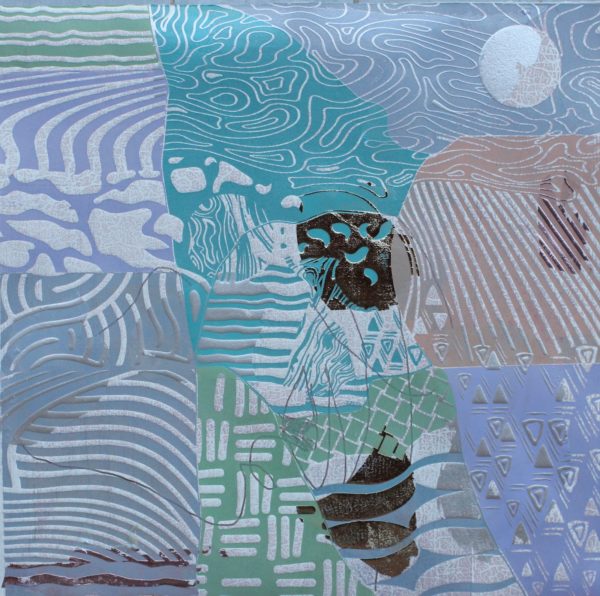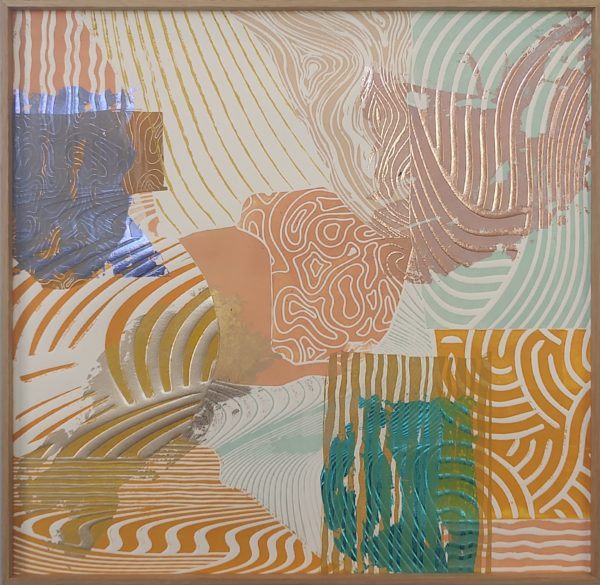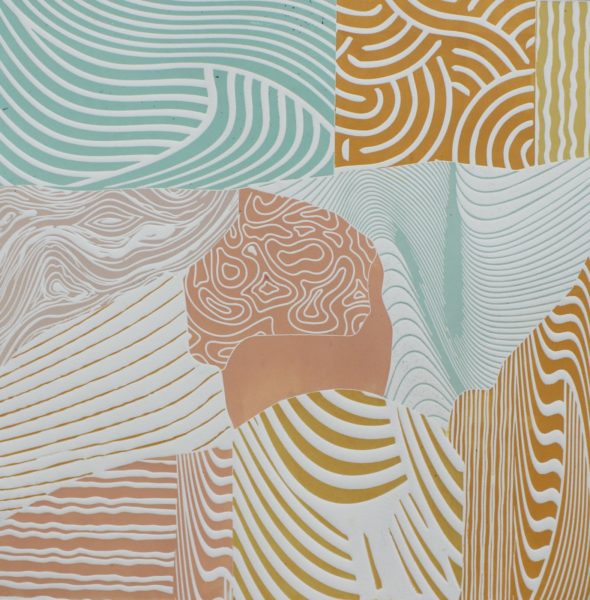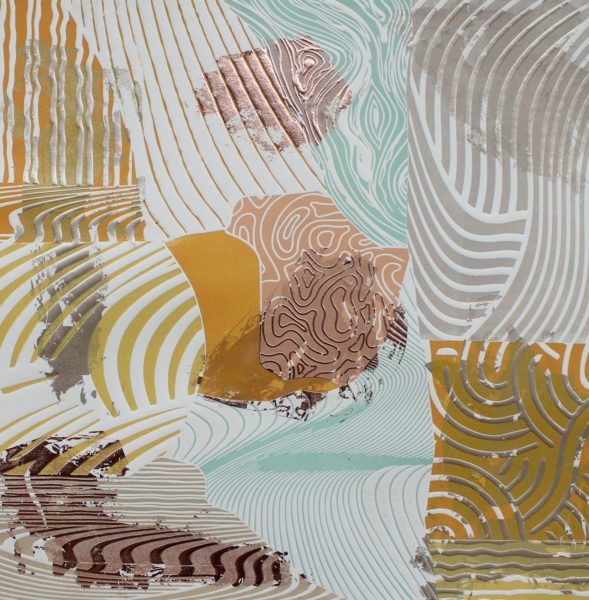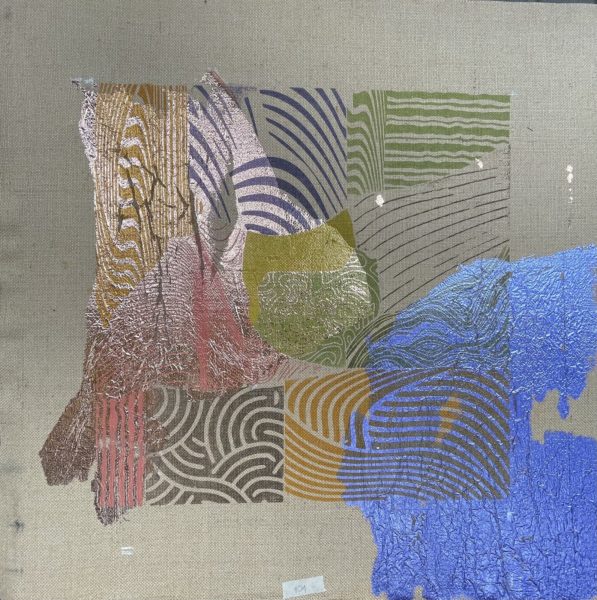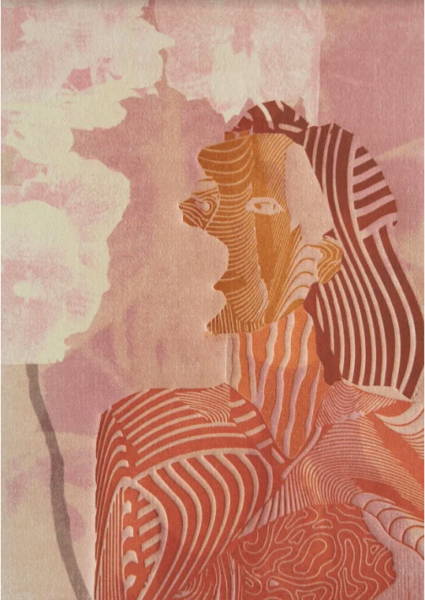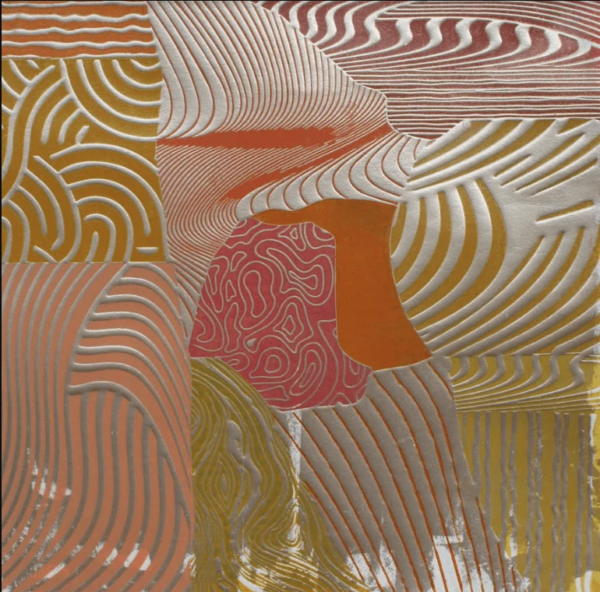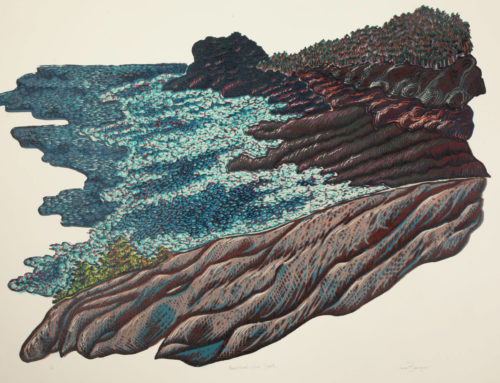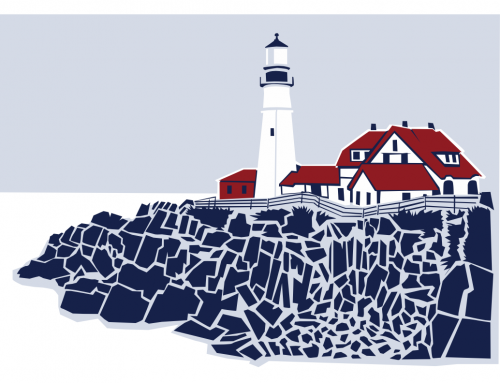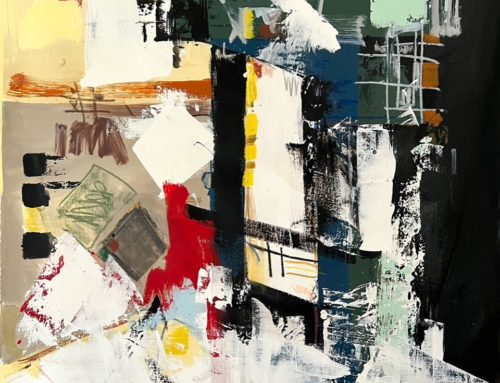Project Description
Ivonne Portillo
Ivonne Portillo is a Colombian visual artist living in Barcelona. Her work celebrates the diversity of the peoples and landscapes of Latin America while emphasizing the vindication of the historical memory of indigenous peoples, many of whom structure their worldview around reciprocal relationships between us and what surrounds us. She transforms the shapes of the earth and its textures into carved and engraved topographies that she then prints on paper or fabric, using oil engraving paint and collage with metallized paper. She is inspired by land art to create abstractions of paths, forests, mountain ranges and bodies of water. The woodcut prints a trace representative of a diverse landscape, much like the Latin American lands which shelter 60% of the planet’s biodiversity. These lands are a natural mosaic that shelter infinite forms of human and non-human life.
Available Work
Achikanain series
“Achikanain” is a series of prints inspired by the landscapes of Latin America. The word “Achikanain” means “footprint” or “trace” in Wayuunaiki, the language of the indigenous Wayúu people who inhabit the northern tip of South America. In this series, the materials speak of the interdependent relationship between nature and society: paper and burlap, plant fiber materials used by humanity for millennia, represent the basic and essential. While the metallic colors represent the mineral richness of the earth: precious metals that were transformed by the indigenous goldsmiths of these territories. Xylography integrates these two materials through impact, creating a unique imprint in each work and leaving a trace on the essence of the earth, just like people do when they inhabit a landscape. Since time immemorial, indigenous peoples have known how to leave a respectful trace.
In “Verses from the Pluriverse” Ernesto Cardenal reminds us that this planet is fire inside: its nucleus as hot as the sun. To make sure, the Nicaraguan poet didn’t have to travel into space. He traveled 30 km west of his hometown and leaned into the Masaya volcano. To look at the mouth of the volcano is to see the center of the earth is to look at the energy of the sun.
“Achikanain” means “footprint” or “trace” in Wayuunaiki, the language of the indigenous Wayúu people who inhabit the northern tip of South America. Our woodcut prints a trace representative of a diverse landscape, much like the Latin American lands which shelter 60% of the planet’s biodiversity. In these works the materials speak of the interdependent relationship between nature and society: burlap, a plant fiber material used by farmers, represents the basic and essential. The metallic colors represent the mineral richness of the earth: the elements transformed by the indigenous goldsmiths of these territories. Xylography integrates these two materials through impact, creating a unique imprint in each work and leaving a trace on the essence of the earth, just like people do when they inhabit a landscape. Since time immemorial, indigenous peoples have known how to leave a respectful trace.
“Orquídeachika” (Orchid-lady) series
“Orquídeachika” is a series inspired by orchids’ unique beauty and extraordinary diversity, being the most extensive plant family on the planet with 25,000 species. The idea for this series came from a photograph taken in Ivonne’s studio which portrays a woman’s face framed by orchids. The woman’s features blend in with the flowers in an interaction that highlights the flowers’ almost female anatomy. Each enhanced the beauty of the other one. Woodcuts were used to print patterns of abstracted landscapes that took on a female and floral form to trace the “Orchid-lady”.
“Lirio de mayo” is one of the 4,270 orchid species in Colombia—the country with the most orchid species in the world. One tree in Colombia could foster more orchid species than an entire forest in a temperate country. This piece is named after the species Cattleya trianae which is one of Colombia’s national symbols. The “lirio de mayo” species is endangered as a result of deforestation, glyphosate aerial spraying and unrelenting harvesting. In fact, orchids are one of the most threatened plant families since deforestation destroys their habitats.
Past Work
For the poet Pablo Neruda, the Latin American continent took form from the heights of Machu Picchu. The Incas abandoned that “high reef of the human dawn” during Spanish colonization and for centuries it remained a “shovel lost in the earliest sand.” The poet recounts his ascent up the Andean ladder of the earth: “I felt infinitely small in the center of that navel of rocks, the navel of a deserted world, proud, towering high, to which I somehow belonged. I felt that my own hands had labored there at some remote point in time, digging furrows, polishing the rocks. I felt Chilean, Peruvian, American. On those difficult heights, among those glorious, scattered ruins, I had found the principles of faith I needed to continue my poetry.”
Amazonian peoples conformed complex and extensive societies organized mainly in chiefdoms. By the year 1541, when colonizer Francisco de Orellana navigated the Amazon river, the towns and cities in its basin sustained more than 3 million people. The world’s largest rainforest has been safeguarded by its indigenous peoples for thousands of years.
Not very far from the driest place on Earth, the river with the largest water flow in the world springs. A thousand kilometers away from the north of Chile’s Atacama desert, river Mantaro flows: the most distant source of the Amazon river. Its tributaries come from the glaciers of the Andes and flow into the Amazon, which crosses Peru, Colombia and Brazil until it reaches the Atlantic Ocean. The mighty and muddy waters the Amazon empties into the sea represent a fifth of all the freshwater in the planet discharged by rivers into oceans.
The ecology of the Amazon rainforest is the result of 10,000 years of land management practiced by its peoples. They domesticated and cultivated plant species like the brazil nut, cacao and rubber trees. To sustain their towns and cities, they slashed and charred parts of the forest to create arable soils. This practice created “Terra Preta” or “Amazonian dark earth” which is still found along the river basins. People abandoned these fertile soils when they fled from colonizers. The Amazon was not a “pristine” rainforest when colonizers arrived. It was (and is) a landscape enriched by the work of its peoples throughout millennia.
This piece is named after an orchid species native to Mexico and Guatemala called Encyclia Hanburyi with lightly fragrant flowers of brownish orange and pink petals. Orchids have been on the earth for 78 million years longer than the human species and they inhabit almost every ecosystem except those with perpetual snow or extremely arid deserts. These flowers that blossom as queens of the forests and jungles possess an important ecological role. They provide food for pollinators and contribute to the nutrient and water cycles of ecosystems.
When the energy of the center of the earth finds a way out, it buries peoples under its fire. In 1985, after 69 years of inactivity, the Colombian town of Armero was swallowed by the lava spat out by the snow-capped Ruiz volcano, originally called Kumanday. Thousands of people were buried under rivers of scalding mud and earth.
Videos
Work with NGOs
Alongside the team of Casa Jaguar Studio (a collective of young Latinamerican artists in diaspora), she creates art that supports grassroots community processes. The sale of this art supports Fundación Gunnekun and Fundación Tejiendo Abya Yala. These two organizations work for the autonomy and self-management of afro-descendant and indigenous communities in Colombia.

